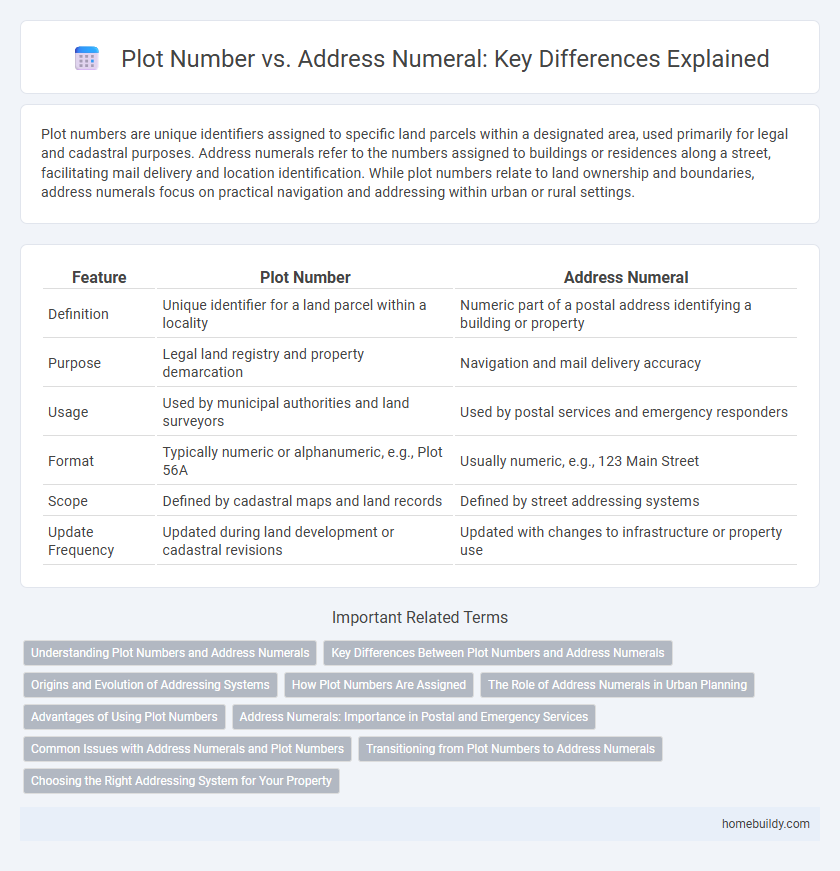Plot numbers are unique identifiers assigned to specific land parcels within a designated area, used primarily for legal and cadastral purposes. Address numerals refer to the numbers assigned to buildings or residences along a street, facilitating mail delivery and location identification. While plot numbers relate to land ownership and boundaries, address numerals focus on practical navigation and addressing within urban or rural settings.
Table of Comparison
| Feature | Plot Number | Address Numeral |
|---|---|---|
| Definition | Unique identifier for a land parcel within a locality | Numeric part of a postal address identifying a building or property |
| Purpose | Legal land registry and property demarcation | Navigation and mail delivery accuracy |
| Usage | Used by municipal authorities and land surveyors | Used by postal services and emergency responders |
| Format | Typically numeric or alphanumeric, e.g., Plot 56A | Usually numeric, e.g., 123 Main Street |
| Scope | Defined by cadastral maps and land records | Defined by street addressing systems |
| Update Frequency | Updated during land development or cadastral revisions | Updated with changes to infrastructure or property use |
Understanding Plot Numbers and Address Numerals
Plot numbers serve as unique identifiers assigned to specific parcels of land within a municipality or development, crucial for land registration and legal documentation. Address numerals, in contrast, indicate the exact location of buildings or residences on a given street, facilitating postal delivery and navigation. While plot numbers are essential for land ownership and legal purposes, address numerals are more practical for everyday use, enabling efficient location-based services and emergency response.
Key Differences Between Plot Numbers and Address Numerals
Plot numbers are unique identifiers assigned to specific parcels of land within a given area, primarily used for legal and land registry purposes, whereas address numerals are elements of a postal address that designate a particular building or entrance for mail delivery. Plot numbers aid in property ownership records and land management systems, while address numerals facilitate navigation and location identification in urban planning. These fundamental differences highlight plot numbers as cadastral references and address numerals as practical tools for everyday locational clarity.
Origins and Evolution of Addressing Systems
Address numerals originated from early urban planning efforts where plot numbers were assigned to land parcels for taxation and property identification purposes, evolving gradually into more complex addressing systems. Plot numbers primarily serve cadastral and legal functions, while address numerals developed to facilitate mail delivery and navigation in growing cities. Over time, the distinction blurred as addressing systems integrated plot numbers with street names and house numbers, reflecting both administrative origins and practical urban needs.
How Plot Numbers Are Assigned
Plot numbers are assigned based on a cadastral surveying system that divides land into distinct parcels for ownership and taxation purposes. Each plot number uniquely identifies a specific piece of land within a surveyed area, often reflecting the sequence of subdivision or geographical features. Unlike address numerals, which relate directly to building entrances for mail delivery and navigation, plot numbers serve primarily as legal and administrative identifiers in land records.
The Role of Address Numerals in Urban Planning
Address numerals play a critical role in urban planning by providing precise location identifiers that enhance navigation, emergency response, and service delivery. Unlike plot numbers, which primarily define land ownership for legal and cadastral purposes, address numerals facilitate daily practical use by residents, businesses, and city services. Optimizing the assignment and visibility of address numerals improves urban management efficiency and supports systematic city development.
Advantages of Using Plot Numbers
Using plot numbers enhances precise location identification within cadastral maps, reducing errors in property registration and legal disputes. Plot numbers provide a standardized reference that simplifies property transactions and land management for government authorities and real estate professionals. This system supports efficient urban planning by clearly demarcating land parcels without ambiguity associated with traditional address numerals.
Address Numerals: Importance in Postal and Emergency Services
Address numerals play a critical role in ensuring accurate and efficient mail delivery by providing a clear identifier linked directly to a specific property location, unlike plot numbers which primarily serve cadastral and legal purposes. Emergency services rely heavily on prominently displayed address numerals to rapidly locate residences or businesses, significantly reducing response times during critical situations. Consistent use of address numerals enhances navigation systems and supports urban planning by linking geographic information to individual buildings within a street or locality.
Common Issues with Address Numerals and Plot Numbers
Address numerals and plot numbers often cause confusion due to inconsistent placement and visibility, leading to difficulties in emergency response and mail delivery. Common issues include missing or damaged numerals, non-standardized fonts, and unclear differentiation between the address number and plot number on signage. Ensuring clear, durable, and standardized address numerals improves location accuracy and reduces misidentification of properties.
Transitioning from Plot Numbers to Address Numerals
Transitioning from plot numbers to address numerals enhances location identification by using standardized numerical sequences linked directly to streets, improving navigation and emergency response times. Address numerals provide clearer, systematic location data compared to plot numbers, which are often ambiguous and inconsistent across regions. Implementing address numerals supports urban planning and postal delivery efficiency, aligning with global addressing standards.
Choosing the Right Addressing System for Your Property
Selecting the right addressing system for your property depends on understanding the difference between plot numbers and address numerals, where plot numbers are primarily used in land registration and legal documentation, while address numerals serve practical purposes in mail delivery and emergency services. Address numerals offer clear identification on physical buildings, enhancing accessibility and location accuracy, whereas plot numbers are often less visible and used mainly in official records. For seamless navigation and services, integrating both systems ensures precise property identification in urban planning and property management.
Plot number vs Address numeral Infographic

 homebuildy.com
homebuildy.com